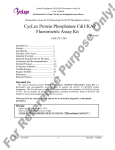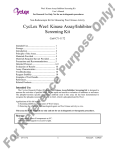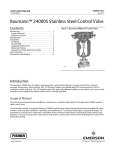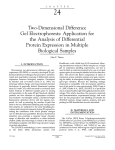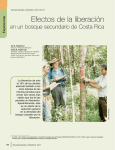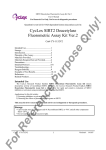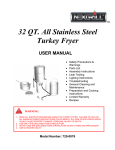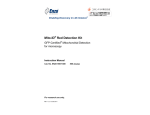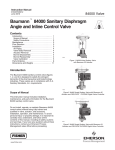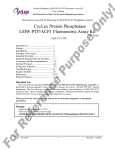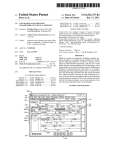Download Data Sheet
Transcript
Fluorometric Assay Kit for Measuring TC-PTP Activity On ly! Protein Tyrosine Phosphatase TC-PTP Fluorometric Assay Kit User’s Manual For Research Use Only, Not for use in diagnostic procedures CycLex Protein Tyrosine Phosphatase TC-PTP Fluorometric Assay Kit 100 Assays Pu rp Intended Use............................................ 1 Storage..................................................... 1 Introduction ............................................. 2 Principle of the Assay.............................. 2-3 Materials Provided .................................. 4 Materials Required but not Provided.….. 4 Precautions and Recommendations......... 4 Detailed Protocol..................................... 5-8 Evaluation of Results .............................. 8-11 Troubleshooting ..................................…12 Reagent Stability ................................... .12 References............................................…13 Related Products..................................….13-14 os e Cat# CY-1351 Intended Use en ce The CycLex Research product Protein Tyrosine Phosphatase TC-PTP Fluorometric Assay Kit is a fluorometric and non-radioactive assay designed to measure the activity of protein tyrosine phosphatase, especially T-cell tyrosine phosphatase (TC-PTP/PTPN2). This 96-well assay is useful for screening inhibitors and modulators of TC-PTP activity in HTS. The kit includes all necessary components, including recombinant, human TC-PTP (full length, residues 1-387 a.a.), for use in preinvestigational drug discovery assays. This assay kit is for research use only and not for use in human, diagnostic, or therapeutic procedures. Storage rR ef er • Upon receipt, store the kit at -70°C. • Don’t expose reagents to excessive light. • AVOID REPEATED FREEZE THAW CYCLES OF “③Recombinant TC-PTP”! Fo Cat#: CY-1351 1 Version#: 141219 On ly! Protein Tyrosine Phosphatase TC-PTP Fluorometric Assay Kit User’s Manual For Research Use Only, Not for use in diagnostic procedures Introduction Principle of the Assay Measurement of TC-PTP activity Pu rp os e The human T-cell PTP (TC-PTP) is an intracellular non-transmembrane phosphatase that was originally cloned from a T-cell cDNA library, but is now known to be expressed in many tissues. TC-PTP contains a conserved catalytic domain and a non-catalytic C-terminal segment that varies in size and function as a result of alternative splicing. Two splice variants differing only in their extreme C termini are expressed. The 48-kDa form of human TC-PTP (TC48) contains a 34-residue hydrophobic tail, which is replaced by a hydrophilic 6-residue sequence in the 45-kDa form (TC45). TC48 localizes to the endoplasmic reticulum (ER) (1, 2), whereas under basal conditions TC45 is localized in the nucleus due to the presence of a bipartite nuclear localization sequence (2-6). TC-PTP has been implicated in the regulation of growth factor receptor signaling, both at the level of receptor tyrosine phosphorylation and in the regulation of downstream signaling events. The overexpression of a truncated, active form of TC-PTP has been shown to reduce the tyrosine phosphorylation of several proteins in PDGF-stimulated cells (1). Both the epidermal growth factor (EGF) receptor and the adaptor protein p52Shc have been identified as substrates for TC-PTP (7). The association between the EGF receptor and the 45-kDa TC-PTP takes place at the plasma membrane (7), whereas the 48-kDa TC-PTP colocalizes with the EGF receptor in the endoplasmic reticulum (ER) (8). In addition, TC-PTP has been linked to the dephosphorylation of the insulin receptor (9) and acts as a negative regulator of cytokine signaling through dephosphorylation of the Jak family of tyrosine kinases (10). ce The Protein Tyrosine Phosphatase TC-PTP Fluorometric Assay Kit is based on an exclusive fluorescence substrate and development reagent combination. This homogenous assay kit is highly sensitive and convenient. This new method of measurement should dramatically raise the efficiency of inhibitor screening and biochemical analysis of these enzymes. The principle of the assay is as follows: 1. First, Fluoro-Phospho-Substrate, which comprises a unique PTP substrate containing a phospho group, is incubated with human TC-PTP enzyme (full length, residues 1-387 a.a., expressed in E. coli). en 2. Dephosphorylation of the substrate sensitizes the substrate so that, in the second step, treatment with the Development solution produces a fluorophore. rR ef er 3. The fluorophore can be easily analyzed with a fluorescence plate reader or a fluorometer. The assay is suitable for high throughput screening applications. Fo Cat#: CY-1351 2 Version#: 141219 Summary of Procedure Two-Step Method On ly! Protein Tyrosine Phosphatase TC-PTP Fluorometric Assay Kit User’s Manual For Research Use Only, Not for use in diagnostic procedures Mix 40 µL of Reaction Buffer and 5 µL of test compound in the wells Add 5 µL of recombinant TC-PTP Incubate for 15 min at room temp. Add 20 µL of Development Buffer and 5 µL of Development Reagent Add 25 µL of Stop Solution os e Incubate for 15 min at room temp. Measure fluorescence at 510-530 nm emission / 482-502 nm excitation One-Step Method Pu rp Mix 40 µL of Reaction Buffer containing Development Reagent and 5 µL of test compounds in the wells Add 5 µL of recombinant TC-PTP Incubate for 10-20 min at room temp. Add 25 µL of Stop Solution ce Measure fluorescence at 510-530 nm emission / 482-502 nm excitation Note: The One-Step Method may provide lower sensitivity or higher background in the presence of high concentrations of Recombinant TC-PTP as compared with the Two-Step Method. en Reminders for Kit Use • Please use all reagents only after they are completely thawed and mixed. rR ef er • Please keep all reagents on ice until use. Fo Cat#: CY-1351 3 Version#: 141219 Materials Provided On ly! Protein Tyrosine Phosphatase TC-PTP Fluorometric Assay Kit User’s Manual For Research Use Only, Not for use in diagnostic procedures All samples and standards should be assayed in duplicate. The following components are supplied and are sufficient for one hundred assays. Components of Kit Storage Below -20°C Below -20°C -70°C Below -20°C -70°C -70°C Below -20°C Below -20°C Room temp. os e Quantity 700 µL x 1 500 µL x 1 500 µL x 1 1000 µL x 2 500 µL x 1 1300 µL x 2 500 µL x 1 100 µL x 1 1 Pu rp Components ① 10X PTP Assay Buffer ② 10X Fluoro-Phospho-Substrate ③ Recombinant TC-PTP, Human (20 m units/µL) ④ Development Buffer ⑤ Development Reagent ⑥ Stop Solution ⑦ Phosphatase Inhibitor (400 mM Sodium Orthovanadate) ⑧ 10X Fluoro-Non-Phospho-Substrate Instruction Manual Materials Required but not Provided ce • Microtiter plate suitable for use with a fluorometric plate reader • Fluorometric plate reader or microtiter plate fluorometer capable of excitation at a wavelength in the range 482-502 nm and detection of emitted light in the range 510-530 nm. • Pipettors: 2-20 µL, 20-200 µL and 200-1000 µL precision pipettors with disposable tips • Multi-channel pipette • Microtiter plate shaker • Distilled water (DW) or equivalent high quality water • Microcentrifuge and tubes for sample preparation • Reagent reservoirs • Ice bucket to keep reagents cold until use • Store the kit at -70°C. en Precautions and Recommendations • Do not expose reagents to excessive light. er • Do not use kit components beyond the indicated kit expiration date. • Rinse all detergent residue from glassware. ef • Use deionized water of the highest quality. • Do not mix reagents from different kits. rR • Do not mouth pipette or ingest any of the reagents. • Do not smoke, eat, or drink when performing the assay or in areas where samples or reagents are Fo Cat#: CY-1351 4 Version#: 141219 On ly! Protein Tyrosine Phosphatase TC-PTP Fluorometric Assay Kit User’s Manual For Research Use Only, Not for use in diagnostic procedures handled. • Human samples may be contaminated with infectious agents. Do not ingest, expose to open wounds or breathe aerosols. Wear protective gloves and dispose of biological samples properly. NOTE: THE FOLLOWING PROCEDURES ARE INTENDED ONLY AS A GUIDELINE. THE OPTIMAL EXPERIMENTAL CONDITIONS WILL VARY DEPENDING ON THE PARAMETERS BEING INVESTIGATED, AND MUST BE DETERMINED BY THE INDIVIDUAL USER. os e Detailed Protocol Pu rp The Protein Tyrosine Phosphatase TC-PTP Fluorometric Assay Kit can measure the enzyme activity of TC-PTP by two different measuring methods, the Two-Step Method and the One-Step Method. The Two-Step Method begins by initiating a reaction of recombinant TC-PTP and the Fluoro-Phospho-Substrate, which is a substrate of TC-PTP, to remove a phosphate group from substrate. The second step involves addition of the Development Solution and the Stop Solution. In the One-Step Method, the reaction is initiated by mixing the Fluoro-Phospho-Substrate and recombinant TC-PTP in the presence of the Development Reagent. The researcher may then stop the reaction by adding Stop Solution and measure the fluorescence intensity. Alternatively, it is possible to measure fluorescence intensity at regular intervals after the reaction is initiated and to determine reaction kinetics without stopping the reaction. Caution and Significance ce • “③Recombinant TC-PTP” and “⑤Development Reagent” should be storaged at -70°C. AVOID REPEATED FREEZE THAW CYCLES OF “③Recombinant TC-PTP”! Making aliquot of “③ Recombinant TC-PTP” is recommended. Thaw the other reagents at room temperature and keep all reagents on ice until use. Use them only after they are completely thawed and mixed. • All samples and standards should be assayed in duplicate. en • Use of a microtiter plate shaker is recommended for complete mixing. er • In order to estimate the inhibitory effect on TC-PTP activity by the test compounds correctly, it is necessary to conduct the control experiment of “Solvent control” at least once for every experiment and “Inhibitor control” at least once for the first experiment, in addition to “Test sample” as indicated in the following table (below). When test chemicals cause an inhibitory effect on TC-PTP activity, the level of increase of fluorescence intensity is weakened as compared with “Solvent control”. The increase in fluorescence intensity is not observed in “Inhibitor control”. ef • If the test compounds or samples have an inhibitory effect on the development reaction, the final fluorescence intensity will not increase. Please use Fluoro-Non-phospho-Substrate instead of Fluoro-phospho-Substrate as “Development control”, and conduct a control experiment that does not add TC-PTP. rR • Conversely, if test compounds or samples have a stimulatory effect on the development reaction, resulting in an increase of fluorescence intensity independent of the phosphatase reaction, the assays cannot be evaluated correctly. To check this possibility, do reactions with or without addition of Fo Cat#: CY-1351 5 Version#: 141219 On ly! Protein Tyrosine Phosphatase TC-PTP Fluorometric Assay Kit User’s Manual For Research Use Only, Not for use in diagnostic procedures Recombinant TC-PTP in the presence of Fluoro-phospho-Substrate. If a test compound has a stimulatory effect on the development reaction, fluorescence intensity will increase even if TC-PTP is not added to the reaction. • If the test compounds or samples themselves emit fluorescence at excitation wavelength: 482-502 nm and fluorescence wavelength: 510-530 nm, the test assay cannot be evaluated correctly. Two-Step Method Table.1: Reaction mixture of Two-Step Method Distilled water ①10X PTP Assay Buffer ②10X Fluoro-Phospho-Substrate ⑧10X Fluoro-Non-Phospho-Substrate Test Compound Solvent of Test Compounds ⑦Phosphatase Inhibitor ③Recombinant TC-PTP (20 m units/µL) Distilled water Total Volume of the mixture Test Sample 30 µL 5 µL 5 µL - Solvent Control 30 µL 5 µL 5 µL - Inhibitor Control 30 µL 5 µL 5 µL - No Enzyme Control 30 µL 5 µL 5 µL - Development Control 30 µL 5 µL 5 µL 5 µL 5 µL 50 µL 5 µL 5 µL 50 µL 5 µL 5 µL 50 µL 5 µL 5 µL 50 µL 5 µL 5 µL 50 µL Pu rp Assay reagents os e 1. Following Table.1 below, first, add “Distilled water”, “①10X PTP Assay Buffer” and “②10X Fluoro-Phospho-Substrate” to microtiter plate wells. Second, add “Test Compound” or “Solvent of Test Compounds” or “⑦Phosphatase Inhibitor” to each well of the microtiter plate and mix well. ce 2. Initiate reactions by adding 5 µL of “③Recombinant TC-PTP” or distilled water to each well and mixing thoroughly at room temperature. 3. Incubate for 15 min or desired length of time at room temperature. en 4. Add 20 µL of “④Development Buffer” and 5 µL of “⑤Development Reagent” to each well of the microtiter plate, and mix thoroughly. 5. Incubate approximately for 15 min at room temperature. er 6. Add 25 µL of “⑥Stop Solution” to each well of the microtiter plate, and mix thoroughly. 7. Measure fluorescence intensity using a microtiter plate fluorometer with excitation at 482-502 nm and emission at 510-530 nm. ef 8. The efficacy of the Test compound is the difference in fluorescence intensity between “Solvent control” and “Test sample”. rR Note: If necessary, it is possible to store the microtiter plate after adding “⑥Stop Solution” for a few hours at room temperature or up to 24 hours at 4°C. The microtiter plate must be sealed to prevent evaporation and kept from excessive light. Fo Cat#: CY-1351 6 Version#: 141219 On ly! Protein Tyrosine Phosphatase TC-PTP Fluorometric Assay Kit User’s Manual For Research Use Only, Not for use in diagnostic procedures One-Step Method 1. Following Table.2 below, first, add “Distilled water”, “①10X PTP Assay Buffer” and “②10X Fluoro-Phospho-Substrate” to microtiter plate wells. Second, add “Test Compound” or “Solvent of Test Compounds” or “⑦Phosphatase Inhibitor” to each well of the microtiter plate. Finally, just before initiation of the reaction with TC-PTP, add 5 µL of “⑤Development Reagent” and mix well. Table.2: Reaction mixture of One-Step Method Total Volume of the mixture Solvent Control 25 µL 5 µL 5 µL - Inhibitor Control 25 µL 5 µL 5 µL - No Enzyme Control 25 µL 5 µL 5 µL - Development Control 25 µL 5 µL 5 µL 5 µL 5 µL 5 µL 50 µL 5 µL 5 µL 5 µL 50 µL 5 µL 5 µL 5 µL 50 µL 5 µL 5 µL 5 µL 50 µL 5 µL 5 µL 5 µL 50 µL os e Distilled water ①10X PTP Assay Buffer ②10X Fluoro-Phospho-Substrate ⑧10X Fluoro-Non-Phospho-Substrate Test Compound Solvent of Test Compounds ⑦Phosphatase Inhibitor ⑤Development Reagent ③Recombinant TC-PTP (20 m units/µL) Distilled water Test Sample 25 µL 5 µL 5 µL - Pu rp Assay reagents 2. Initiate reactions by adding 5 µL of “③Recombinant TC-PTP” or distilled water to each well and mixing thoroughly at room temperature. ce 3. Add 25 µL of “⑥Stop Solution” to each well at appropriate time, and measure fluorescence intensity using a microtiter plate fluorometer with excitation at 482-502 nm and emission at 510-530 nm. Alternate procedure en 4. The efficacy of the Test compound is the difference in fluorescence intensity between “Solvent control” and “Test sample”. 3’. Read fluorescence intensity for several minutes using a microtiter plate fluorometer with excitation at 482-502 nm and emission at 510-530 nm. er 4’. Measure and calculate the rate of reaction while the reaction velocity remains constant. ef Note-1: In some cases, the One-Step Method may cause higher backgrounds and lower sensitivity as compared with the Two-Step Method. In many cases, there will be no measurable difference between the two methods. Choose the most suitable method for your particular experiment. rR Note-2: If necessary, it is possible to store the microtiter plate after adding “⑥Stop Solution” for a few hours at room temperature or up to 24 hours at 4°C. The microtiter plate must be sealed to prevent evaporation and kept from excessive light. Fo Cat#: CY-1351 7 Version#: 141219 On ly! Protein Tyrosine Phosphatase TC-PTP Fluorometric Assay Kit User’s Manual For Research Use Only, Not for use in diagnostic procedures Evaluation of Results Analysis of Inhibitor Effect % Intensity os e 1. Run reactions with test compounds and solvent as described in the Detailed Protocol. 2. Subtract fluorescence intensity of “No Enzyme Control” from all experimental samples (Test Samples and Solvent Control). 3. Calculate the % Intensity: Fluorescence Intensity of Test Sample % Intensity = X 100 Fluorescence Intensity of Solvent Control Pu rp Note: This % Intensity is a rough value of enzyme activity or inhibition. For greater accuracy, plot a standard curve of TC-PTP for each new set of reactions and estimate the % Activity (see below). Fig.1 TC-PTP Inhibition Curve by Sodium Orthovanadate using the Two-Step Method 120% Relative Intensity 100% 80% 60% ce 40% 20% 0% 0.1 1 10 100 rR ef er en Sodium Orthovanadate Conc. (mM) Fo Cat#: CY-1351 8 Version#: 141219 Fig.2 TC-PTP Inhibition Curve by RK-682 using the Two-Step Method 120% Relative Intensity 100% 80% 60% os e 40% 20% 0% 0.1 1 10 100 1000 RK-682 Conc. (uM) Pu rp Analysis of Enzyme Activity TC-PTP Standard Curve and % Activity On ly! Protein Tyrosine Phosphatase TC-PTP Fluorometric Assay Kit User’s Manual For Research Use Only, Not for use in diagnostic procedures 1. Dilute the ①10X PTP Assay buffer 1:9 with distilled water to make 1X PTP Assay Buffer. 2. Make serial dilutions of TC-PTP with 1X PTP Assay Buffer (ex. 100%, 75%, 50%, 25% 10% and 0%). 3. Run reactions with solvent and serial dilutions of TC-PTP as described in the Detailed Protocol. 4. Plot standard curve data (dose dependent curve data) as fluorescence intensity at 510-530 nm versus dose of TC-PTP (unit/assay) 5. Obtain a line-fit to the data using appropriate calculations. 6. Use the slope and Y-intercept to calculate the amount of TC-PTP activity for the experimental data. ce Fig.3 Dose Dependency of Recombinant TC-PTP using the Two-Step Method 1,600,000 en 1,400,000 1,200,000 Counts 1,000,000 800,000 er 600,000 400,000 200,000 rR ef 0 Fo Cat#: CY-1351 5.00 3.75 2.50 1.25 0.50 0.05 0.00 Recombinant TC-PTP (uL) 9 Version#: 141219 On ly! Protein Tyrosine Phosphatase TC-PTP Fluorometric Assay Kit User’s Manual For Research Use Only, Not for use in diagnostic procedures Fig.4 Comparison between Two-Step Method and One-Step Method in Dose Dependency of Recombinant TC-PTP 120% Tow-Step Method One-Step Method 100% Counts 80% 40% 20% 0% 5.00 3.75 2.50 1.25 0.50 0.05 Pu rp Recombinant TC-PTP (uL) os e 60% Analysis of Kinetics Time Course Curve (Only for One-Step Method) ce 1. Run reactions as described in the Detailed Protocol. 2. Subtract fluorescence intensity at the 0 time from all reaction time points. 3. Plot fluorescence intensity at 510-530 nm versus reaction time. 4. Determine the reaction time range in which the increase in fluorescence intensity at 510-530 nm is linear. 5. Calculate activity: Fluorescence Intensity of Test Sample Activity (reaction velocity) = en Reaction time (min.) rR ef er Note: Usually, the linear range is from 0 to 10 min. This value is variable depending on reaction conditions and storage/handling of the TC-PTP. Decreasing the amount of TC-PTP in the assay may help to lengthen the time range. Fo Cat#: CY-1351 10 Version#: 141219 Fig.5 Time Course Curve of Recombinant TC-PTP using the One-Step Method 2,500,000 Recombinat TC-PTP Dose (uL) 2,000,000 1,500,000 Counts On ly! Protein Tyrosine Phosphatase TC-PTP Fluorometric Assay Kit User’s Manual For Research Use Only, Not for use in diagnostic procedures 5.00 2.50 1,000,000 os e 1.25 0.50 500,000 0.00 0 0.0 5.0 10.0 15.0 rR ef er en ce Pu rp Reaction Time (min.) Fo Cat#: CY-1351 11 Version#: 141219 On ly! Protein Tyrosine Phosphatase TC-PTP Fluorometric Assay Kit User’s Manual For Research Use Only, Not for use in diagnostic procedures Troubleshooting 1. The TC-PTP positive control should be run in duplicate using the protocol described in the Detailed Protocol. Incubation times or temperatures significantly different from those specified may give erroneous results. 2. The reaction curve is nearly a straight line if the kinetics of the assay is of the first order. Variations in the protocol can lead to non-linearity of the curve, as can assay kinetics of other than first order. For a non-linear curve, point to point or quadratic curve fit methods should be used. os e 3. Poor duplicates, accompanied by elevated values for wells containing no sample, indicate inaccurate dispensing of assay reagents. If all instructions in the Detailed Protocol were followed accurately, such results indicate a need for multi-channel pipette maintenance. Reagent Stability Pu rp All of the reagents included in the T-cell Protein Tyrosine Phosphatase Fluorometric Assay Kit have been tested for stability. Reagents should not be used beyond the stated expiration date. Upon receipt, all the kit should be stored at -70°C. After use, return the kit to -70°C as soon as possible. rR ef er en ce For research use only, not for use in human, diagnostic or therapeutic procedures Fo Cat#: CY-1351 12 Version#: 141219 References On ly! Protein Tyrosine Phosphatase TC-PTP Fluorometric Assay Kit User’s Manual For Research Use Only, Not for use in diagnostic procedures 1. Cool, D. E., Tonks, N. K., Charbonneau, H., Fischer, E. H., and Krebs, E. G. Proc. Natl. Acad. Sci. U. S. A. 87, 7280-7284, 1990 2. Lorenzen, J. A., Dadabay, C. Y., and E. H., F. J. Cell Biol. 131, 631-643, 1995 3. Mosinger, B., Jr., Tillmann, U., Westphal, H., and Tremblay, M. L. Proc. Natl. Acad. Sci. U. S. A. 89, 499-503, 1992 os e 4. Champion-Arnaud, P., Gesnel, M. C., Foulkes, N., Ronsin, C., Sassone-Corsi, P., and Breathnach, R. Oncogene 6, 1203-1209, 1991 5. Tillmann, U., Wagner, J., Boerboom, D., Westphal, H., and Tremblay, M. L. Mol. Cell. Biol. 14, 3030-3040, 1994 Pu rp 6. Tiganis, T., Flint, A. J., Adam, S. A., and Tonks, N. K. J. Biol. Chem. 272, 21548-21557, 1997 7. Tiganis, T., A. M. Bennett, K. S. Ravichandran, and N. K. Tonks. Mol. Cell. Biol. 18: 1622-1634, 1998. 8. Tiganis, T., B. E. Kemp, and N. K. Tonks. J. Biol. Chem. 274: 27768-27775, 1999. 9. Galic, S., M. Klingler-Hoffmann, M. T. Fodero-Tavoletti, M. A. Puryer, T. C. Meng, N. K. Tonks, and T. Tiganis. Mol. Cell. Biol. 23: 2096-2108, 2003. 10. Simoncic, P. D., A. Lee-Loy, D. L. Barber, M. L. Tremblay, and C. J. McGlade. Curr. Biol. 12: 446-453, 2002. ce Related Products er en * CycLex Protein Tyrosine Phosphatase PTP1B Fluorometric Assay Kit: Cat# CY-1350 * CycLex Protein Tyrosine Phosphatase TC-PTP Fluorometric Assay Kit: Cat# CY-1351 * CycLex Protein Phosphatase Cdc25A Fluorometric Assay Kit: Cat# CY-1352 * CycLex Protein Phosphatase Cdc25B Fluorometric Assay Kit: Cat# CY-1353 * CycLex Protein Phosphatase Cdc25C Fluorometric Assay Kit: Cat# CY-1354 * CycLex Protein Phosphatase Cdc25 Combo Fluorometric Assay Kit: Cat# CY-1355 * CycLex Protein Phosphatase Cdi1/KAP Fluorometric Assay Kit: Cat# CY-1356 * CycLex Protein Phosphatase LMW-PTP/ACP1 Fluorometric Assay Kit: Cat# CY-1358 * CycLex Protein Phosphatase DUSP1/MKP-1 Fluorometric Assay Kit: Cat# CY-1373 rR ef * Protein Tyrosine Phosphatase PTPRA 1st Catalytic Domain: Cat# CY-E1301 * Protein Tyrosine Phosphatase PTPRA 2nd Catalytic Domain: Cat# CY-E1302 * Protein Tyrosine Phosphatase PTPRD 2nd Catalytic Domain: Cat# CY-E1307 * Protein Tyrosine Phosphatase PTPRE 1st Catalytic Domain: Cat# CY-E1308 * Protein Tyrosine Phosphatase PTPRF 1st Catalytic Domain: Cat# CY-E1310 * Protein Tyrosine Phosphatase PTPRK 1st Catalytic Domain: Cat# CY-E1316 * Protein Tyrosine Phosphatase PTPRQ: Cat# CY-E1323 * Protein Tyrosine Phosphatase PTP4A2: Cat# CY-E1341 * Recombinant Cdc25A (Catalytic domain): Cat# CY-E1352 * Recombinant Cdc25B (Catalytic domain): Cat# CY-E1353 Fo Cat#: CY-1351 13 Version#: 141219 ce Pu rp os e * Recombinant Cdc25C (Catalytic domain): Cat# CY-E1354 * Recombinant Cdi1/KAP: Cat# CY-E1356 * Protein Phosphatase PP5: Cat# CY-E1359 * Protein Tyrosine Phosphatase PTPN3/PTPH1: Cat# CY-E1360 * Protein Tyrosine Phosphatase PTPN6/SHP-1: Cat# CY-E1363 * Protein Tyrosine Phosphatase PTPN7/HePTP: Cat# CY-E1364 * Protein Tyrosine Phosphatase PTPN8/PTPN22: Cat# CY-E1365 * Protein Tyrosine Phosphatase PTPN9/MEG2: Cat# CY-E1366 * Protein Tyrosine Phosphatase PTPN11/SHP-2: Cat# CY-E1367 * Protein Tyrosine Phosphatase PTPN12/PTP-PEST: Cat# CY-E1368 * Protein Tyrosine Phosphatase PTPN13/FAP-1: Cat# CY-E1369 * Protein Tyrosine Phosphatase PTPN14/PEZ: Cat# CY-E1370 * Protein Tyrosine Phosphatase PTPN21/PTPD1: Cat# CY-E1372 * Protein Phosphatase DUSP1/MKP-1: Cat# CY-E1373 On ly! Protein Tyrosine Phosphatase TC-PTP Fluorometric Assay Kit User’s Manual For Research Use Only, Not for use in diagnostic procedures en PRODUCED BY er CycLex Co., Ltd. 1063-103 Terasawaoka Ina, Nagano 396-0002 Japan Fax: +81-265-76-7618 e-mail: [email protected] URL: http://www.cyclex.co.jp rR ef CycLex/CircuLex products are supplied for research use only. CycLex/CircuLex products and components thereof may not be resold, modified for resale, or used to manufacture commercial products without prior written approval from CycLex Co., Ltd.. To inquire about licensing for such commercial use, please contact us via email. Fo Cat#: CY-1351 14 Version#: 141219














